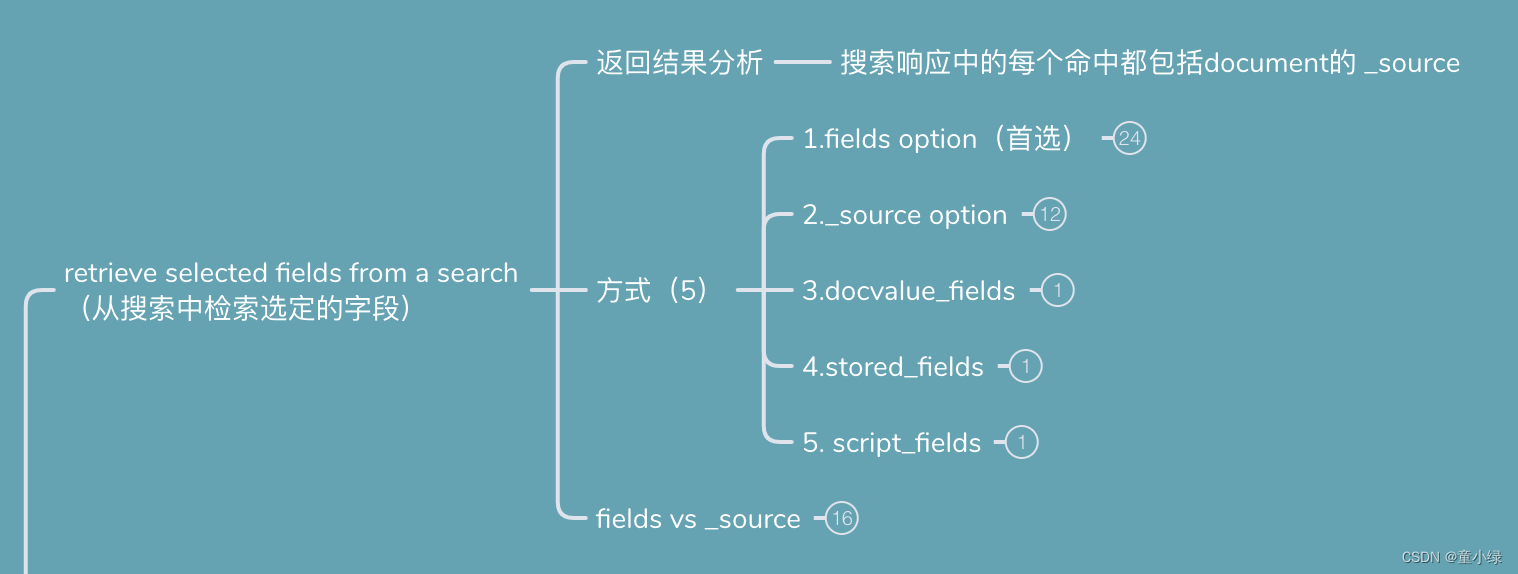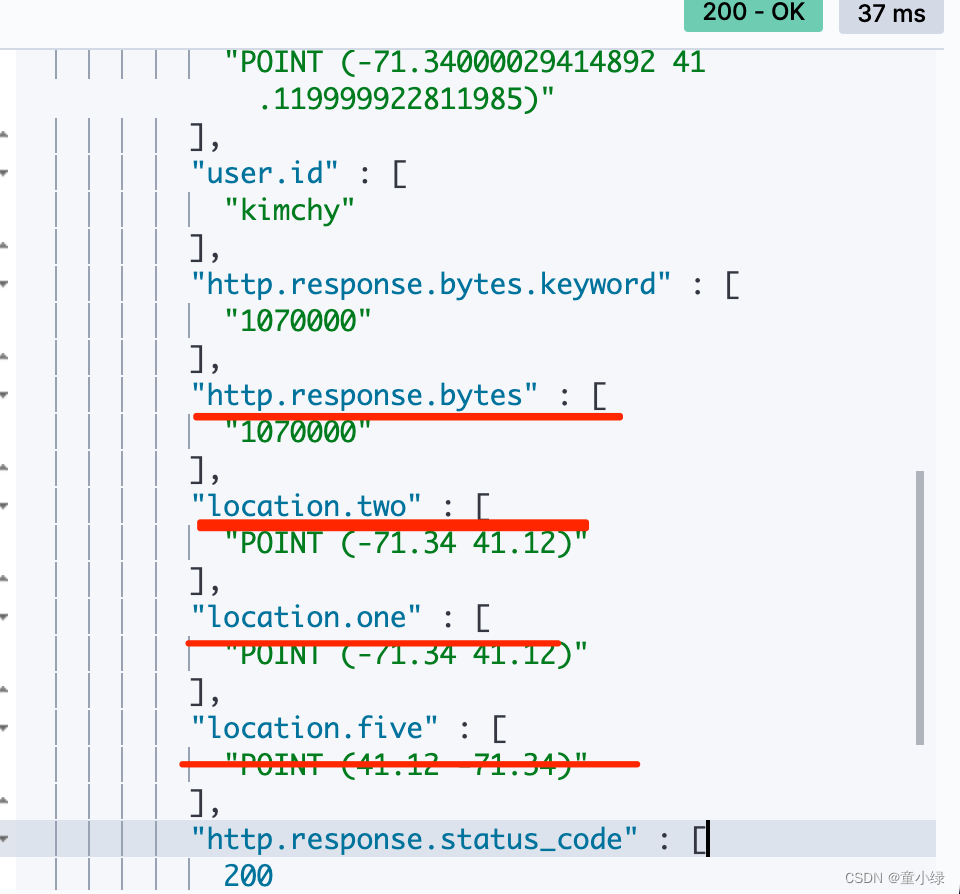从搜索中检索选定的字段
Retrieve selected fields from a search(文档学习)
https://www.elastic.co/guide/en/elasticsearch/reference/7.13/search-fields.html#source-filtering
默认情况下,搜索响应中的每个命中都包括document的 _source部分,这是在索引文档时提供的整个JSON对象。

建议使用两种方法从搜索查询中检索选定字段:
(1)使用 fields 选项提取索引映射中存在的字段的值
(2)如果需要访问在索引时传递的原始数据,请使用_source选项
我们可以同时使用这两种方法,但首选fields选项,因为它同时参考文档数据和索引映射。在某些情况下,我们可能希望使用其他方法检索数据。
其他的话还有三种,补充使用
(3)docvalue_fields
使用 docvalue_fields 参数获取选定字段的值。当返回一个数量比较少的doc value(例如keyword和date),这可能是一个不错的选择。
(4)stored_fields
使用 stored_fields 参数获取特定存储字段(使用store映射选项的字段)的值。
(5)script_fields
使用 script_fields 参数来检索每个命中的脚本评估,提取/输出新字段。
The fields option
要检索搜索响应中的特定字段,请使用fields参数。因为它参考索引映射,所以fields参数提供了几个优于直接引用_source的优点。具体而言,字段参数:
- 以与映射类型匹配的标准化方式返回每个值
- 接受multi-fileds和field aliases
- 格式化date和spatial(空间)数据类型
- 检索runtime field values
- 返回脚本在索引时计算的字段
还考虑了其他映射选项,包括上面的ignore_above、ignore_malformed和null_value。
-
ignore_above
字符串元素的长度超过ignore_above不会被索引或存储 -
ignore_malformed
允许的映射类型中忽略格式错误的内容 -
null_value
fields选项返回值的方式与Elasticsearch索引值的方式相匹配。对于标准字段,这意味着fields选项在_source中查找值,然后使用映射解析并格式化它们。
(1)Search for specific fields
搜索指定的字段。比如text,keyword,objec,nested,date,spatial等字段都可以。
使用对象表示法,可以传递format参数以自定义返回日期或地理空间值的格式。
- date and date_nanos 字段 使用date from
- Spatial fields 使用 GeoJSON/wkt
以下搜索请求使用fields参数检索user.id字段、以http.response.开头的所有字段和@timestamp字段的值。
数据源
##数据源
DELETE my-index-000001
##spatial 要定类型,必须先创建mapping
PUT my-index-000001
{
"mappings": {
"properties": {
"location.one": {"type": "geo_point"},
"location.two": {"type": "geo_point"},
"location.three": {"type": "geo_point"},
"location.four": {"type": "geo_point"},
"location.five": {"type": "geo_point"},
"username": {
"type": "nested",
"properties": {
"first" : { "type" : "keyword" },
"last" : { "type" : "keyword" }
}
},
"timestamp":{
"type": "date",
"format": "yyyy-MM-dd HH:mm:ss||yyyy-MM-dd||epoch_millis",
"ignore_malformed": false,
"null_value": null
}
}
}
}
PUT my-index-000001/_doc/1
{
"user": {
"id": "kimchy",
"name": "kimchy wang",
"age": 12
},
"http": {
"response": {
"status_code": 200,
"bytes": "1070000"
}
},
"@timestamp": "2018-10-18T12:20:51.603Z",
"timestamp": 1539865251603,
"ip_addr": "192.168.1.1",
"location": {
"one": {"lat": 41.12,"lon": -71.34},
"two": "41.12,-71.34",
"three": "drm3btev3e86",
"four": [41.12, -71.34],
"five" : "POINT (41.12 -71.34)"
},
"username":{
"first": "John",
"last": "Smith"
}
}
##查看mapping结构
GET /my-index-000001/_mapping
fields指定字段 请求
##1.object字段
##2.前缀模糊匹配
##3.date 用户epoch_millis输出
##4.Spatial 用wkt输出
##"_source": false 不返回_source
POST my-index-000001/_search
{
"query": {
"match": {
"user.id": "kimchy"
}
},
"fields": [
"user.id",
"http.response.*",
{
"field": "@timestamp",
"format": "epoch_millis"
},
{
"field": "location.*",
"format": "geojson"
},
{
"field": "location.*",
"format": "wkt"
}
],
"_source": false
}
fields指定字段返回 响应结果
##1.object字段
##2.前缀模糊匹配
##3.date 用户epoch_millis输出
##4.Spatial 用wkt输出
##"_source": false 不返回_source
{
"took" : 2,
"timed_out" : false,
"_shards" : {
"total" : 1,
"successful" : 1,
"skipped" : 0,
"failed" : 0
},
"hits" : {
"total" : {
"value" : 1,
"relation" : "eq"
},
"max_score" : 0.2876821,
"hits" : [
{
"_index" : "my-index-000001",
"_type" : "_doc",
"_id" : "1",
"_score" : 0.2876821,
"fields" : {
"@timestamp" : [
"1539865251603"
],
"location.three" : [
"POINT (-71.34000029414892 41.119999922811985)"
],
"user.id" : [
"kimchy"
],
"http.response.bytes.keyword" : [
"1070000"
],
"http.response.bytes" : [
"1070000"
],
"location.two" : [
"POINT (-71.34 41.12)"
],
"location.one" : [
"POINT (-71.34 41.12)"
],
"location.five" : [
"POINT (41.12 -71.34)"
],
"http.response.status_code" : [
200
],
"location.four" : [
"POINT (41.12 -71.34)"
]
}
}
]
}
}
(2)Response always returns an array
- 响应总是返回一个数组。
- fields响应始终为每个字段返回一个值数组,即使_source中只有一个值。这是因为Elasticsearch没有专用的数组类型,任何字段都可能包含多个值。fields参数也不能保证数组值按特定顺序返回。
- 响应将值作为一个平面列表包含在每个命中的字段部分中。因为fields参数不获取整个对象,所以只返回leaf字段。
- 这里对比nested的结果看,就知道平铺列表形式了。

(3)fields response for nested 检索nested字段
- nested字段的字段响应与常规对象字段的字段响应略有不同。常规对象字段中的叶值以平面列表的形式返回,而嵌套字段中的值则分组以保持原始嵌套数组中每个对象的独立性。对于嵌套字段数组中的每个条目,值将再次以平面列表的形式返回,除非父嵌套对象中存在其他嵌套字段,在这种情况下,对更深的嵌套字段再次重复相同的过程。
- 给定以下映射,其中user是嵌套字段,检索用户字段下的所有字段:
数据源
DELETE my-index-000002
PUT my-index-000002
{
"mappings": {
"properties": {
"group" : { "type" : "keyword" },
"user": {
"type": "nested",
"properties": {
"first" : { "type" : "keyword" },
"last" : { "type" : "keyword" }
}
},
"addr":{
"properties": {
"country": { "type" : "keyword" },
"province": { "type" : "keyword" },
"city": { "type" : "keyword" },
"description": { "type" : "keyword" }
}
}
}
}
}
##user-nested tel-object(非定义) add-object(定义)
PUT my-index-000002/_doc/1?refresh=true
{
"group": "fans",
"user": [
{
"first": "John",
"last": "Smith"
},
{
"first": "Alice",
"last": "White"
}
],
"tel": {
"number": "13334567890",
"area_code": "86"
},
"addr": {
"country": "CN",
"province": "YN",
"city": "KM",
"description": "地址信息"
}
}
GET /my-index-000002/_mapping
fields指定nested 请求
- 1.tel-object(非定义) 区分了text,keyword
- 2.add-object(定义) keyword
- 3.user-nested
POST my-index-000002/_search
{
"fields": ["*"],
"_source": false
}
## 或者
POST my-index-000002/_search
{
"fields": ["user.first","user.last"],
"_source": false
}
fields指定nested 响应结果
##响应
##1.tel-object(非定义) 区分了text,keyword
##"tel.number"
##"tel.number.keyword"
##"tel.area_code"
##"tel.area_code.keyword"
##2.add-object(定义) keyword
##"addr.country"
##"addr.description"
##"addr.province"
##"addr.city"
##3.user-nested (一层一层的以数组形式组织,而不是平铺的设计)
##"user" : ["last" : ["Smith" ],"first" : [ "John"] },{"last" : ["White"],"first" : ["Alice"]}]
{
"took" : 1,
"timed_out" : false,
"_shards" : {
"total" : 1,
"successful" : 1,
"skipped" : 0,
"failed" : 0
},
"hits" : {
"total" : {
"value" : 1,
"relation" : "eq"
},
"max_score" : 1.0,
"hits" : [
{
"_index" : "my-index-000002",
"_type" : "_doc",
"_id" : "1",
"_score" : 1.0,
"fields" : {
"tel.number" : [
"13334567890"
],
"tel.area_code.keyword" : [
"86"
],
"tel.number.keyword" : [
"13334567890"
],
"addr.country" : [
"CN"
],
"tel.area_code" : [
"86"
],
"addr.description" : [
"地址信息"
],
"addr.province" : [
"YN"
],
"addr.city" : [
"KM"
],
"user" : [
{
"last" : [
"Smith"
],
"first" : [
"John"
]
},
{
"last" : [
"White"
],
"first" : [
"Alice"
]
}
],
"group" : [
"fans"
]
}
}
]
}
}
(4)Retrieve unmapped fields 检索未映射的字段
- 默认情况下,“fields”参数仅返回映射字段的值。但是,Elasticsearch允许在_source中存储未映射的字段,例如将动态字段映射设置为false,或者使用enabled : false的对象字段。这些选项禁用对象内容的解析和索引。
- 要从_source检索对象中未映射的字段,请使用“fields”部分中的“include_unmapped”选项:
enabled : false 禁用所有映射
DELETE my-index-000003
##禁用所有映射
PUT my-index-000003
{
"mappings": {
"enabled": false
}
}
##index
PUT my-index-000003/_doc/1?refresh=true
{
"user": {
"id": "kimchy"
},
"session_data": {
"object": {
"some_field": "some_value"
}
}
}
include_unmapped设置返回为映射的字段 请求
include_unmapped设置返回为映射的字段,也包括与此字段模式匹配的未映射字段。
##设置session_data.object.* 的include_unmapped属性为true可查询到为未映射的session_data.object.* 前缀开头的字段。
POST my-index-000003/_search
{
"fields": [
"user.id",
{
"field": "session_data.object.*",
"include_unmapped" : true
}
],
"_source": false
}
POST my-index-000003/_search
{
"fields": [
"user.id",
{
"field": "session_data.object.*",
"include_unmapped" : true
}
],
"_source": false
}
include_unmapped 响应结果
- 响应将包含session_data.object.*路径下的字段结果,即使字段未映射。user_id字段也未映射,但它不会包含在响应中,因为对于该字段模式,include_unmapped未设置为true。
{
"took" : 0,
"timed_out" : false,
"_shards" : {
"total" : 1,
"successful" : 1,
"skipped" : 0,
"failed" : 0
},
"hits" : {
"total" : {
"value" : 1,
"relation" : "eq"
},
"max_score" : 1.0,
"hits" : [
{
"_index" : "my-index-000003",
"_type" : "_doc",
"_id" : "1",
"_score" : 1.0,
"fields" : {
"session_data.object.some_field" : [
"some_value"
]
}
}
]
}
}
The _source option
- 我们可以使用_source参数选择返回源的哪些字段。这称为源过滤。
以下搜索API请求将_source request body参数设置为false。响应中不包括文档源。
1.响应中不包括文档源_source
数据源
DELETE my-index-000004
PUT my-index-000004/_doc/1?refresh=true
{
"group": "fans",
"user": {
"id": "kimchy",
"age": 12,
"description": "用户信息"
},
"tel": {
"number": "13334567890",
"area_code": "86",
"description": "手机信息"
},
"addr": {
"country": "CN",
"province": "YN",
"city": "KM",
"description": "地址信息"
}
}
返回_source部分 设置 “_source”: true
GET /my-index-000004/_search
{
"_source": true,
"query": {
"match": {
"user.id": "kimchy"
}
}
}
返回_source部分 响应结果
"hits" : [
{
"_index" : "my-index-000004",
"_type" : "_doc",
"_id" : "1",
"_score" : 0.2876821,
"_source" : {
"group" : "fans",
"user" : {
"id" : "kimchy",
"age" : 12,
"description" : "用户信息"
},
"tel" : {
"number" : "13334567890",
"area_code" : "86",
"description" : "手机信息"
},
"addr" : {
"country" : "CN",
"province" : "YN",
"city" : "KM",
"description" : "地址信息"
}
}
}
]
不返回_source部分 设置 “_source”: false
GET /my-index-000004/_search
{
"_source": false,
"query": {
"match": {
"user.id": "kimchy"
}
}
}
不返回_source部分 响应结果
"hits" : [
{
"_index" : "my-index-000004",
"_type" : "_doc",
"_id" : "1",
"_score" : 0.2876821
}
]
2.返回指定的字段 “_source”: [“tel.*”]
返回指定的单字段 请求
若要仅返回源字段的子集,请在_source参数中指定通配符(*)模式。以下搜索API请求仅返回tel字段及其属性的源。
GET /my-index-000004/_search
{
"_source": ["tel.*"],
"query": {
"match": {
"user.id": "kimchy"
}
}
}
返回指定的单字段 响应结果
- 返回"tel.*"字段
{
"took" : 0,
"timed_out" : false,
"_shards" : {
"total" : 1,
"successful" : 1,
"skipped" : 0,
"failed" : 0
},
"hits" : {
"total" : {
"value" : 1,
"relation" : "eq"
},
"max_score" : 0.2876821,
"hits" : [
{
"_index" : "my-index-000004",
"_type" : "_doc",
"_id" : "1",
"_score" : 0.2876821




